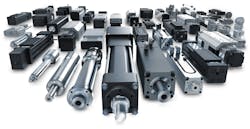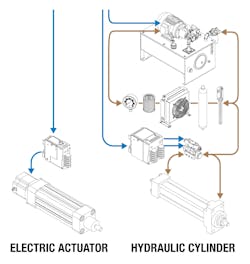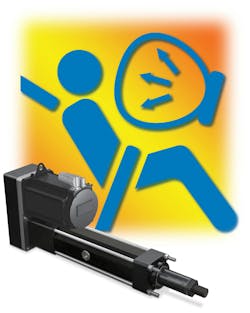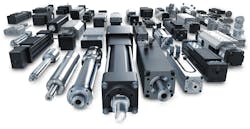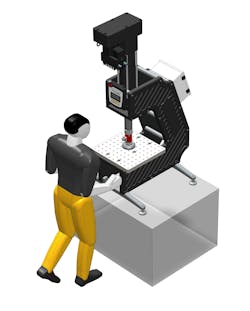Unleashing the Capabilities of the Linear Servo Press in Manufacturing
At a Glance:
- This article explores the advantages of servo-electric presses, along with some design considerations to keep in mind when choosing the actuator.
- The author outlines the differences between servo-mechanical and linear servo press technologies for developing new press equipment, retrofitting hydraulic systems or modernizing existing production lines.
Linear servo presses represent a significant advancement in industrial press technology, offering a compelling alternative to traditional hydraulic and servo-mechanical presses. These presses can deliver high precision, speed and flexibility, making them an ideal choice for high-precision press applications.
Because this technology combines the high forces typical of hydraulic systems with the precision and control of servo mechanisms, linear servo presses offer a versatile and efficient solution for many industrial applications, including automotive, aerospace, electronics and medical device manufacturing.
Comparing Press Technologies
Linear servo presses offer several advantages over traditional mechanical servo presses. Unlike mechanical systems that incorporate crankshafts and flywheels, linear servo presses integrate direct-drive linear actuators—a design that eliminates energy loss associated with mechanical transmission, allowing for more precise positioning and speed control.
Linear servo presses are also a compelling alternative to hydraulic presses, which have been the industry standard for high-force applications. Linear servo presses offer a high force range, faster stroke speeds and more flexibility in re-tasking and switching between different press recipes. They also maintain a compact footprint and flexible stroke length, making them suitable for a variety of manufacturing environments.
The Advantages of Linear Servo Press Technology
Linear servo presses offer unparalleled precision and control, which are critical in high-precision manufacturing environments. The electric linear actuator design allows for accurate positioning and speed control. This precision is particularly beneficial in applications such as metal stamping, where consistent part production can reduce scrap rates and improve productivity.
The ability to program motion profiles ensures that complex assembly sequences can be implemented with high accuracy, enhancing the quality of assembled components. This level of control is not achievable with traditional hydraulic or mechanical presses, making linear servo presses a superior choice for industries requiring exact force application and positioning.
READ MORE: An Engineer’s Primer on the Actuator Component
Linear servo presses are also more energy efficient since they eliminate energy loss by directly converting electrical energy into linear motion. This direct conversion leads to better energy efficiency, reducing operational costs and environmental impact. The absence of complex fluid power systems and improved maintenance predictability reduces the risk of unplanned downtime, eliminates hydraulic leaks and enhances the overall cost-effectiveness of these presses.
And finally, linear servo presses provide greater flexibility and versatility compared to traditional press technologies. The ability to switch between different press recipes quickly and efficiently allows manufacturers to adapt to changing production requirements without significant downtime. This flexibility is particularly advantageous in industries like automotive and aerospace, where diverse and complex components are produced.
The compact footprint and flexible stroke length of linear servo presses also enable them to be integrated into various production environments, making them suitable for a wide range of applications, from metal forming to electronics assembly.
Applications of Linear Servo Presses
Thanks to their long list of benefits, linear servo presses excel in many industrial applications, including the following:
Metal stamping. Linear servo presses are used in metal stamping operations like blanking, piercing, bending and forming. Their precise control and positioning capabilities ensure consistent part production, reducing waste and enhancing overall productivity.
Assembly and joining. In assembly applications, such as bearing assembly and the insertion of seals and retention rings, precision control of force and position is crucial. Linear servo presses support programmable motion profiles, enabling complex assembly sequences and ensuring proper alignment and quality of components.
Riveting and fastening. For applications requiring reliable joint integrity, linear servo presses offer the flexibility to adjust force levels based on fastening requirements. This adaptability is essential in industries like aerospace and automotive, where stringent quality and performance standards are mandatory.
READ MORE: Deliver Robust Automated Systems Through Servo Maintenance
Testing and quality control. Linear servo presses are used in applications like compression tests, tension tests, peel tests and other material property evaluations. Their precision ensures accurate and repeatable test results, which are vital for maintaining product quality.
Electronics and microelectronics assembly. In the assembly of delicate components like printed circuit boards (PCB), linear servo presses provide precise force application and accommodate various bonding techniques, including ultrasonic and thermal compression bonding.
Medical device manufacturing. Linear servo presses are used in high-tolerance applications for assembly, joining and forming operations, ensuring the quality and reliability of medical devices.
Design Considerations for Linear Servo Presses
When designing your linear servo press, it’s important to keep in mind several design considerations:
Force and load requirements. Evaluate the required tonnage force and load capacity. Different operations, such as blanking, bending or deep drawing, demand varying levels of force and stroke. Selecting electric actuators with sufficient force capabilities is crucial for handling the specific requirements of each application.
Speed and acceleration. Determine the required speed and acceleration parameters for both the press approach and the press operation. Consider the desired production rates, cycle times, dwell times and part quality. Specify electric actuators that can achieve the required cycle time while maintaining accurate positioning and force control.
READ MORE: The Future of Servo Technology in Harsh Environments
Environmental factors. Considerations include temperature, humidity, dust, washdown and vibration. Choosing electric actuators designed for specific environmental conditions ensures long-term performance and reliability. This design consideration is crucial for maintaining the integrity and functionality of the press in diverse industrial settings.
Safety considerations. Assess the safety requirements of the press application and consider features like overload protection, emergency stop functionality and safety interlocks—e.g., light curtains and two-hand controls. In order to protect operators and equipment, make sure your electric actuators comply with relevant safety standards and can be integrated into the overall press machine safety system.
Integration and compatibility. The integration of the linear servo press into existing production systems is another essential consideration. The press should be compatible with the current control systems and production processes. This step includes selecting servo motors and drives that are compatible with standard control interfaces and protocols.
Positioning accuracy and repeatability. To guarantee accurate and repeatable part production, electric actuators should provide high-resolution position feedback and have low positional errors. The precision of the press is influenced by the screw and bearing technologies used, which should be evaluated based on the tolerances and precision needed for the application.
Duty cycle and continuous operation. Factors such as production volume, operating hours and thermal management play a role in determining the appropriate electric actuators. Selecting actuators that can handle the anticipated duty cycle without compromising performance or reliability is essential. Incorrect sizing, particularly concerning the duty cycle, can lead to premature failure.
Maintenance and serviceability. Although linear actuators represent the lowest maintenance among press technologies, it’s critical to evaluate the actuators for ease of maintenance and serviceability. The design should allow for straightforward access to parts that may require regular inspection or replacement. For higher tonnage units, linear actuator assemblies may require repair or refurbishment at the original manufacturer. In these circumstances, it is important to partner with a manufacturer who has a strong repair program. This step will help minimize downtime and ensure the press operates efficiently over its lifespan.
Force Feedback. Traditional linear servo actuators can achieve reasonable force feedback through simple motor current monitoring. When the system is calibrated with a load cell, this can achieve up to 2% accuracy. If force feedback with higher accuracy is required, load cells can be integrated into the press machine design in a variety of ways. These can include simple press fixture strain gauges, rod end load cells, low profile load cells integrated into the press fixture or load cells integrated into the linear actuator. To find the optimal force feedback method, review your application requirements and compare each method’s pros and cons.
Linear Servo Presses and Future Trends
Linear servo presses are poised to play a crucial role in the evolution of smart manufacturing. For example, their ability to provide real-time data on force, speed and position makes them ideal for integration into Industry 4.0 environments. This integration allows manufacturers to optimize production processes through data analytics, predictive maintenance and enhanced quality control.
The development of new materials and composites is also creating new opportunities for linear servo presses in various industries. As more manufacturers explore lightweight, high-strength materials for applications like automotive, aerospace and consumer electronics, there is a growing need for precise forming and joining processes. Linear servo presses—with their programmable motion profiles and precise force control—are well-suited to handle these advanced materials.
In addition, increasing environmental and regulatory pressures are driving industries to adopt more sustainable manufacturing practices. Linear servo presses, with their energy-efficient operation and reduced environmental impact, align with these sustainability goals. Unlike traditional hydraulic presses, which rely on fluid compression and can be prone to leaks and contamination, linear servo presses offer a cleaner and more efficient alternative.
Learn More
As industries continue to evolve, the adoption of linear servo press technology is expected to grow, driven by their ability to enhance productivity, lower scrap rates and improve energy and manufacturing efficiency. The ongoing advancements in linear servo press technology promise to further extend their advantages over traditional hydraulic machines, making them an increasingly attractive option for manufacturers seeking to modernize their production lines.
The Actuator: Cornerstone of a Linear Servo Press
Manufacturers of linear servo presses often work with a linear actuator specialist like Tolomatic, to select or design high-force electric actuators as the cornerstone of their products. With the wide variety of servo motors, controls and standard components, more engineers are also choosing to customize actuators according to their unique application requirements.
Here’s a rundown of some of the solutions offered by Tolomatic:
High-force actuators. Choose from a wide range of high-force linear actuators, including the RSX Series. For example, the RSX20P is a press-specific electric linear actuator that includes a proprietary, precision-ground planetary roller screw, oversized tie rods, steel front flange and bearing system optimized for high force press moves.
Hydraulic replacement. RSX, RSA and IMA actuators are ideal for retrofitting and replacing hydraulic cylinders or mechanical flywheel systems in existing press machinery. Tolomatic also offers stainless-steel IP69K hygienic actuators (RSH and IMA-S) for demanding washdown applications.
Actuator modifications. If your requirements fall outside of standard product configurations, a capable linear motion control partner can often modify a solution to meet your needs, including stroke, speed, force or other requirements. Starting with a proven product platform lets you evolve the actuator solution to your unique requirements. Design and model a linear actuator into your press application using sizing and selection software. You, or a machine builder, can then complete the design and specify the press fixture, load cell and safety devices to your requirements.
Custom solutions. Some manufacturing challenges simply can’t be solved by existing standard linear actuators. That’s when you should consider a custom designed system. A capable linear motion systems expert can offer decades of experience and innovative products to help get you to a press solution quickly.
